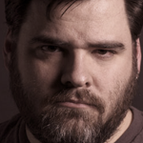Does Godfather II really need its movie license?
The film's name could actually detract from an otherwise respectable Don sim - here's why
When EA Games decided toadaptThe Godfather intoa gamein 2006, it was a controversial decision, in no small part because The Godfather was never an action movie. It wasviolent, sure, but not in a way that translates tocoherent gameplay. EA worked around the problem by creating anew, parallel storylinethat put players in the shoes of a previously unknown Corleone soldier, whoworked offscreento bring about key events in the movie. And while the movie's fans cried foul, it still made for acompelling game.
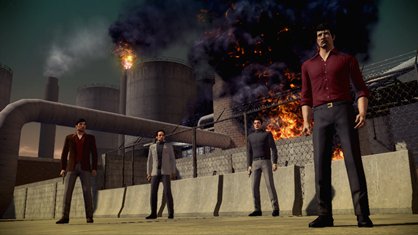
Above: Meet your new family, none of whom are from the movie
With the sequel, however, the problem is even more pronounced. Although The Godfather: Part II features its share of mob hits, most of the action happens during the movie's frequent flashbacks to the 1900s. And considering that The Godfather II (the game drops the "Part" from its title) won't feature any of those flashbacks, it begs the question of exactly what the connection between the movie and the game will be - and whether there even needs to be one at all.
Here's what we know so far: The Godfather II casts you as Dominic Corleone, another previously unknown Mob soldier who serves as underboss to the first game's protagonist, Aldo "The Player" Trapani. Near the beginning of the game, the two mobsters accompany their bosses, Michael and FredoCorleone, to Havana, Cuba - and just like in the movie, everyone flees when Castro's Communist rebels take the city in January of 1959. Aldo is killed while trying to escape Havana, and because he ended the first game as head of the Corleones' criminal empire, Dominic is next in line for the job.
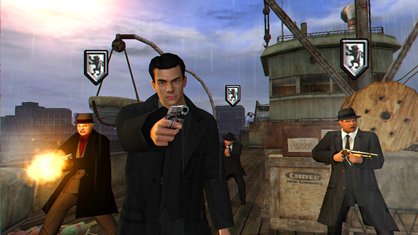
Above: Hey, remember this guy, who you created and spent all that time building up in the first game? Yeah, he's kind of dead now
Beyond that, though, the game's storyline appears to be set apart from the events of the movie. It'd almost have to be, seeing as the "modern" parts of The Godfather: Part II mainly revolve around Senate hearings and high-level Mob intrigue. Admittedly, we're basing that assertion on our brief, early first look at the unfinished game - but aside from the reappearance of consigliere Tom Hagen (played again by Robert Duvall) and several other characters from the film, the connections between game and movie already seem weak. Forced, even. On top of that, the game apparently takes place during the '60s, while the movie's plot ends in 1959. And with Aldo dead right off the bat, even its connections to the first game are tenuous.
So why is Godfather II a Godfather game at all? Putting aside the argument that recognizable licenses sell better, the game already looks poised to disappoint fans who invested themselves in the first game's story, to say nothing of fans of the movie it allegedly adapts. Divorcing it from the Godfather name, however, would enable it tobe judgedon its own merits. And with no expectations about it remaining faithful to the source material, it would be a lot easier to see that EA has created something that looks strong enough to stand on its own, movie snobs be damned.
Weekly digests, tales from the communities you love, and more
Take Dead Space, for example. When creating it, EA could have easily bought Aliens or any other sci-fi/horror license, plugged the right enemies in and relied on the strength of the license to help the game sell. Instead, they created their own universe, characters, enemies and storyline, and so far it's working out brilliantly. It's proof that, yes, EA is capable of creating great original games.
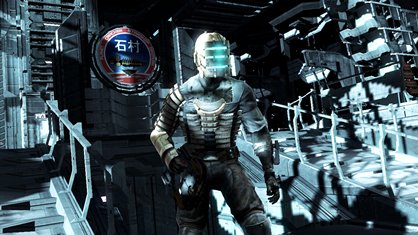
Above: Dead Space could easily have been Aliens or The Thing. But it isn't, and it's more interesting because of that
With Godfather II, however, EA has essentially created its own characters, enemies and storyline, and then shoehorned them into a universe where they might not fit. That's going to automatically earn the game some derision, and that's too bad.Because apart from the expectations its license creates, Godfather II looks really interesting.
Godfather II keeps the Grand Theft Auto-inspired gameplay of the original (including the first game's cool Black Hand control scheme), but expands the action into three distinct cities - Havana, Miami and a redesigned New York - and puts a much bigger emphasis on strategy. You're not just a lone hood anymore - you're a Don, and you'll spend as much time directing your troops and managing your criminal empire as you will gunning down thugs and taking over rackets and businesses.
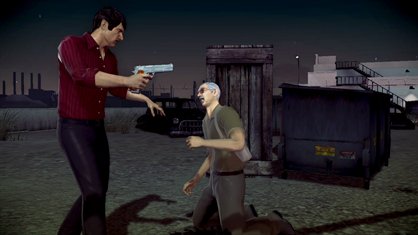
In actual gameplay, being the Don translates into what may be the first squad-based open-world crime game. Real crime bosses don't go it alone, and you'll be accompanied at all times by at least three members of your crew. Divided into an underboss, a couple of capos and a handful of soldiers, your team of thugs all have distinct personalities, skills and weaknesses, and can be ordered around as needed. One guy, for example, might be able to cut the phone lines at a racket you're trying to take over, preventing its guards from calling for help - but he might also have an irritating habit of wandering off to talk to women when his mind should be on business.
Your crew is also fully customizable, right down to the clothes they wear and the weapons they carry, and their usefulness extends beyond just following you around and watching your back. If you want to disrupt a rival mob's racket, for example, you can send a couple of wiseguys with demolition skills over to bomb it, destroying its ability to make money for a little while. It's even possible to take your crew online to battle other players' custom mobs.
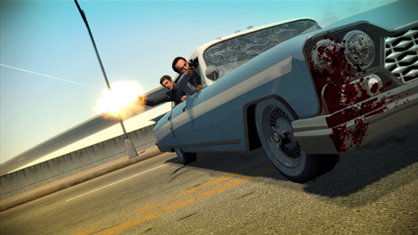
Of course, your influence as Don extends beyond your meathead underlings. At any time during the game, you can switch over to what's called the Don View, which gives you an overview of the city you're in, complete with details on the business fronts and illegal enterprises owned by you and the five rival families you're competing with.
You can also see how many men are guarding each one, which is key to the underlying strategy of Godfather II. Unlike in the first Godfather, where taking over a racket or a business automatically meant it would be guarded by a few Corleone flunkies, it's up to you to assign protection and concentrate your troops in certain areas - which, again, you'll do via Don View.
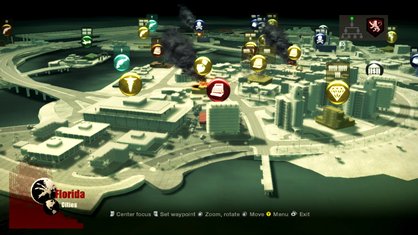
Above: Don View gives you a full overview of your growing empire
The game's strategy elements - which unfold in real time regardless of what you're doing in the game world - were illustrated to us using a card game created by the game's designers. The game's rackets (represented by individual cards) are divided into certain types - arms dealing, drugs, gambling, money laundering, pornography, etc. - and if you can bring all rackets of a certain type under your control, you'll earn a strategic bonus for your crew. Owning a complete arms ring, for example, will give all your guys bulletproof vests, while running all of a city's chop shops will give you a fleet of armored cars.
Of course, you'll need to protect your interests against the game's five families, who will essentially be playing the same strategy game you are. Usually, that means hiring goons to guard your rackets, although that costs money - and if the racket isn't making enough money to support its goons, you're going to run into problems. The good news is that the other families will see you as just another rival, instead of their main target, and they'll constantly be at war with each other as well as you. Overall, we were told that the idea was to take the same dynamic that rules a card game - the changing strategies, the unspoken alliances - and replicate it with the game's artificial intelligence.
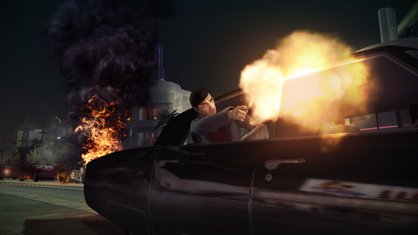
Unlike in the simple card game we played, though, you'll be able to use outside influences to give you an edge in the game. During the demo, we saw Dominic hanging out at an adult film studio - complete with topless "actresses" - where he met up with Miami's district attorney (we don't know why a DA would commit political suicide by hanging out at a porn shoot, but OK). The DA asked Dominic to apply a little pressure to an uncooperative restaurant owner; do as he asks, and you'll get a "Sting Card," a favor that can be cashed in to have police raid a compound before you do, or arrest key members of a rival family. You can also take matters into your own hands, identifying key members of rival clans and - once you've uncovered what their "kill conditions" are - taking them out of the game permanently.
Of course, beyond the strategy is the same mobster-stomping, racket-toppling gameplay that made the first game so interesting. As we said earlier, the first game's Black Hand control scheme is back, enabling you to throw punches with the right analog stick (a la Fight Night), execute your enemies with a gun at close range, grab them by the lapels, strangle them or toss them into convenient hazards. And there are a lot more hazards this time around; when intimidating the restaurant owner we mentioned earlier, for example, Dominic mashed his face into the restaurant's hot stove.
Like in the first game, getting business owners to come around to your side is all about knowing how to apply just enough pressure. The more you rough them up and destroy their things, the more money they'll offer just to get you to go away - but if you push them too far, they'll freak out and attack you, and you won't get anything at all.
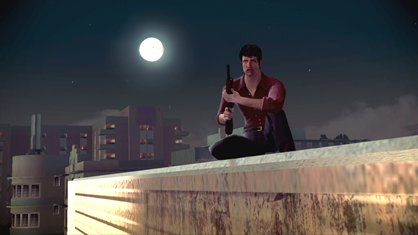
Above: Dominic's pretty fugly in these first screens, but you'll be able to customize him with the game's MobFace feature
As we mentioned earlier, the action unfolds across three cities, and we're told each will have a distinct flavor. Miami will be fairly spread out, New York will be compact and densely populated and Havana - which you'll be able to resume operations in when certain conditions are met - will have what the developers described as "a very old-world feel." The only action we saw took place in Miami, which already looked a hell of a lot more organic and open than the first game's rigid, constricting vision of New York. (It still didn't look anywhere near as sharp as GTA IV - although the game is still in an early stage of development and we expect that to change.) That said, it's worth noting that - when we asked how the game's size would compare to other crime games, like GTA IV or GTA: San Andreas - we were told only that the developers are focusing on density, rather than volume.
Finally, it's important to note that - while the bulk of the game will focus on taking over criminal operations, roughing up store owners (who hopefully will own a more diverse set of buildings this time) and playing the underlying strategy game as a Don -there'll still be GTA-style missions you can take onto drive the story forward.
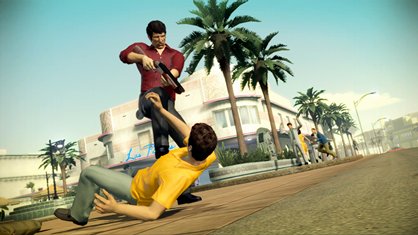
We're just not sure what connection, if any, that story will have to the one in the movie - unless it's meant to bridge the story gap between Godfather: Part II and The Godfather: PartIII, a game version of which might have the rare distinction of being better than its widely despised namesake. To be honest, though, we're still not sure why that connection is even necessary; simply titling the game something like The Don would enable it tostrikeout on its own,avoiding the negative stigma that inevitably comes with trying to turn one of the best crime dramas of all time into a mostly unrelated videogame.
Whatever the case, we'll have a clearer idea of what The Godfather II has in store as we move toward the game's eventual 2009 release.
Hear more about this article in this week'sTalkRadar.


Can military-grade insanity in Venezuela beat out Niko Bellic and Liberty City? We've got nine reasons why it will

We unearth the secrets surrounding EA's upcoming survival-gorror

Our videogame-based homage to the famous opening sequence

It all began long before "sandbox" became a gaming-household word
Aug 15, 2008
